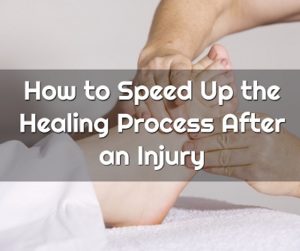 Following an injury, you are often in a rush to heal so that you can back to exercising and just your everyday normal routine. While you can’t rush the resting and ice stage, there are some things you can do to help healing go more smoothly.
Following an injury, you are often in a rush to heal so that you can back to exercising and just your everyday normal routine. While you can’t rush the resting and ice stage, there are some things you can do to help healing go more smoothly.
Apply Ice Right Away
As soon as you get an injury, you need to ice it right away. The icing is really important because it helps to reduce swelling and inflammation, which also adds to the pain. You don’t want to ice it too much, but try about 5-10 minutes, remove it for a few minutes, then ice it again. Keep doing this until the swelling begins to go down.
Try icing it a few times a day until you start to experience relief. Make sure the ice pack is covered with a thin towel so that it doesn’t cause damage to your skin from the direct contact.
Do Stretches When You Can
Another thing that will help your injured extremity or joint to heal is stretching it. This is something you should not do right away when you have limited range of motion, but gradually over time. Give it a few days of ice and rest, then slowly try moving that part of your body.
Don’t push it, so do this very slowly until you know what you can manage. Gentle stretch by moving it in different directions, trying to do a little more each day. This will strengthen it and get it ready for regular movement before too long.
Get Plenty of Nutrients
The food you eat can also play an important role in the healing process of an injury. Sitting around and eating nothing but junk food is only going to make things worse. There are certain nutrients that can help injuries to heal, including herbs like turmeric, plenty of water, and various other vitamins and minerals.
Talk to your doctor about changing your diet when you are healing so that you can ensure you are eating enough of all the important nutrients. This will also help keep you from gaining too much weight before you back to exercising.
Get a Massage
Massaging the area is also a great way to start speeding up the healing process. You can start by massaging that tendon or muscle yourself, or actually get a professional massage. This reduces swelling, helps with the pain, and stretches the area all at the same time. Just make sure you tell the massage therapist what injury you have so that
they can be cautious.






